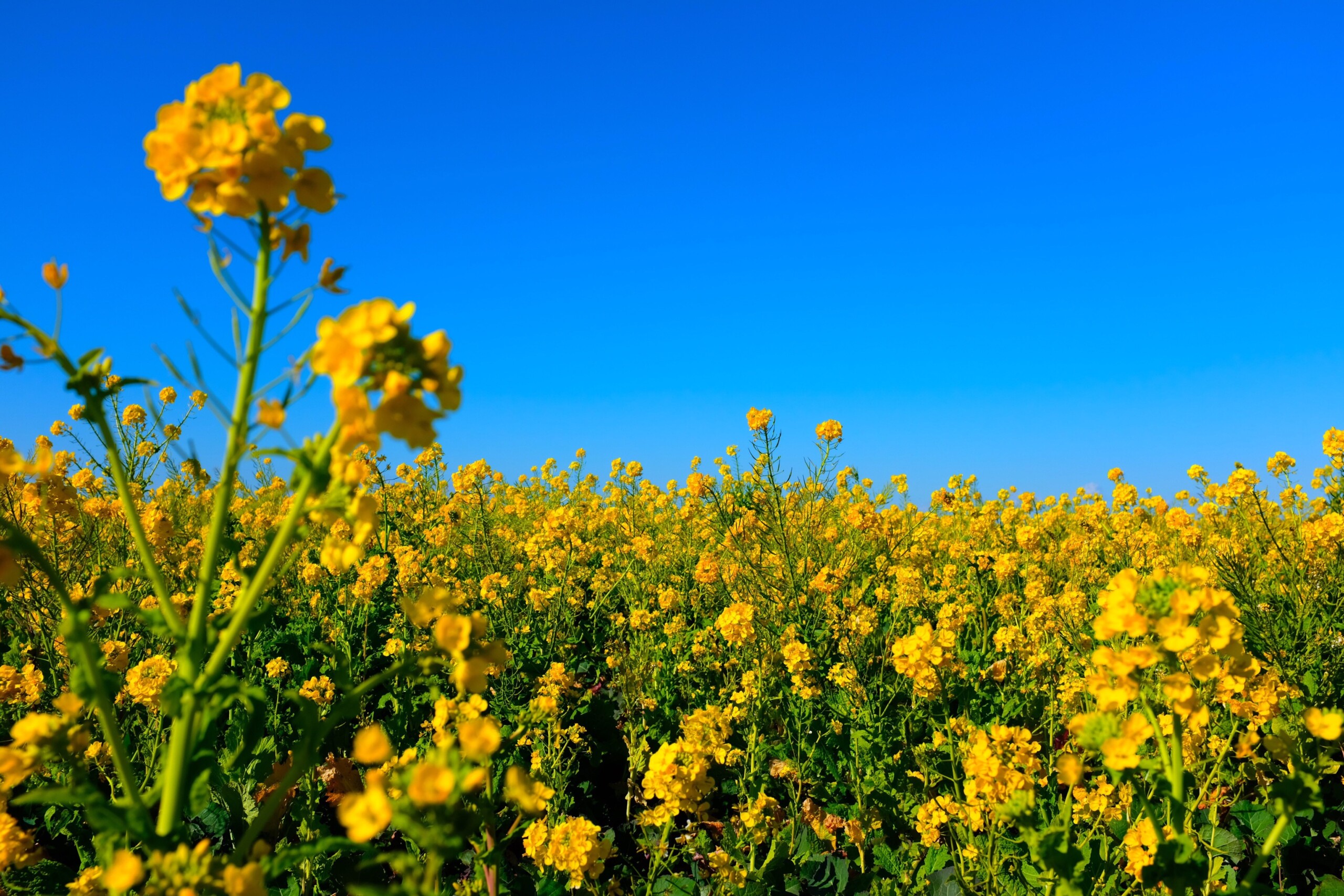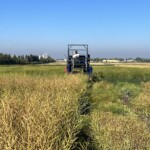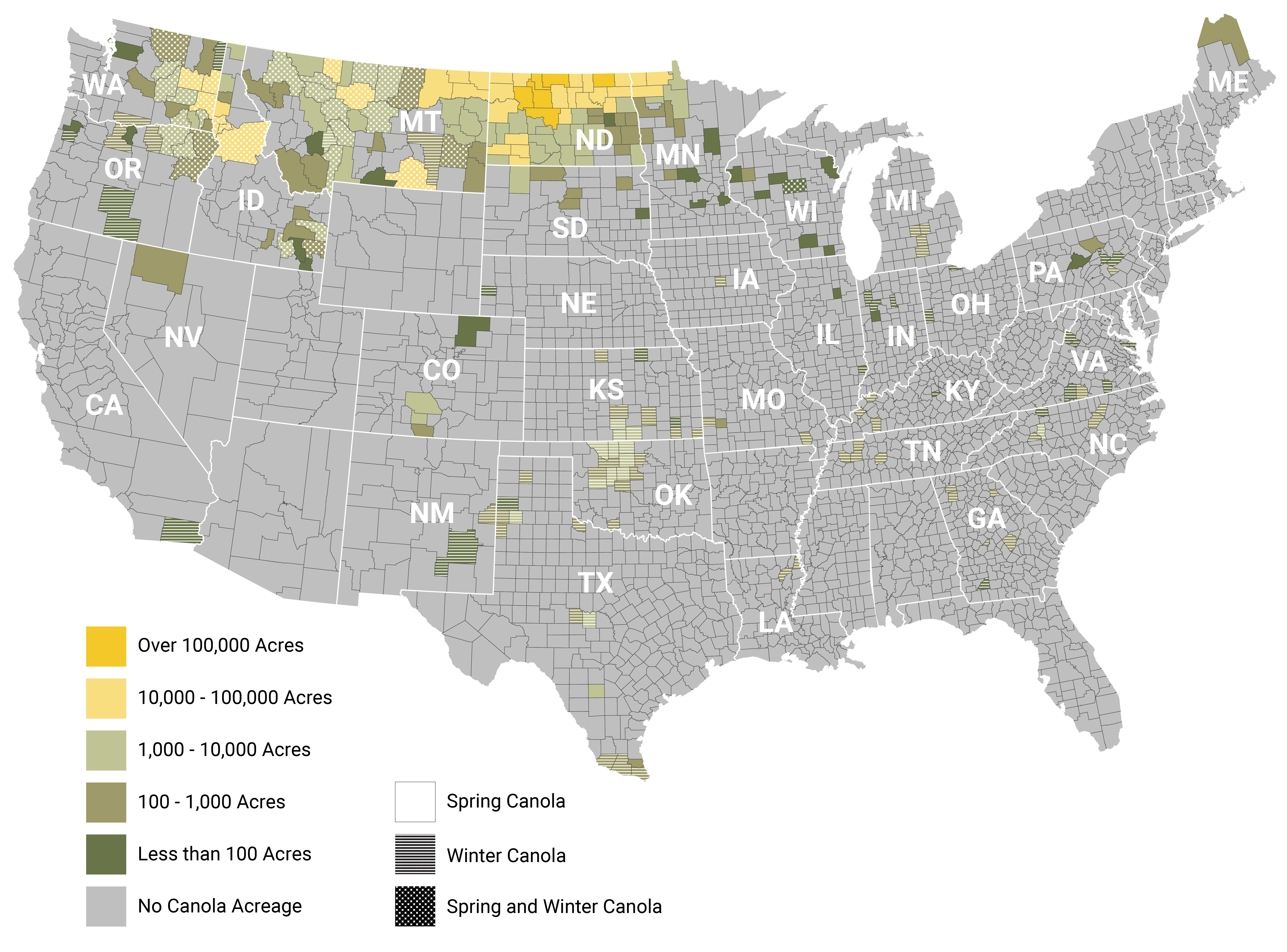Canola Quick Bytes
A supplement to U.S. Canola Digest
Capitol Hill
 Now that the U.S. House of Representatives has finally elected a new speaker (Mike Johnson R-LA), Congress can refocus on pending legislation, such as the fiscal year 2024 agriculture appropriations and new farm bill. However, neither measure is expected to be enacted this year. Speculation is increasing that there will be a Continuing Resolution through early 2024 to give Congress more time to reach agreement on the annual appropriations bills. The farm bill is also likely to see an extension, possibly for as long as one year. The U.S. Canola Association (USCA) continues to communicate its priorities for these important pieces of legislation. Now that the U.S. House of Representatives has finally elected a new speaker (Mike Johnson R-LA), Congress can refocus on pending legislation, such as the fiscal year 2024 agriculture appropriations and new farm bill. However, neither measure is expected to be enacted this year. Speculation is increasing that there will be a Continuing Resolution through early 2024 to give Congress more time to reach agreement on the annual appropriations bills. The farm bill is also likely to see an extension, possibly for as long as one year. The U.S. Canola Association (USCA) continues to communicate its priorities for these important pieces of legislation.
The USCA submitted comments and joined with hundreds of other agricultural groups, including the Northern Canola Growers Association and Pacific Northwest Canola Association, on joint comments to the Environmental Protection Agency on the draft Herbicide Strategy Framework for Endangered Species Act (ESA) requirements. This framework describes the analyses conducted to estimate endangered species’ exposure to herbicides, assess the potential impacts of these pesticides and determine mitigations necessary to protect the endangered species. The strategy proposes a mitigation menu to reduce herbicide exposure to listed species from spray drift, run-off and erosion. It also identifies the geographic extent of mitigation measures and describes an implementation plan.
 The U.S. Department of Agriculture’s (USDA’s) National Institute of Food and Agriculture (NIFA) invests in the “supplemental and alternative crops” (SAC) of canola and hemp via dedicated funding of about $1 million. Called the SAC Competitive Grants Program, it supports projects that lead to expanded adaptation and increased acreage of these two crops in the United States. This includes “breeding, testing and development of superior performing varieties … and production practices that result in improved cost efficiencies, reduced grower risks, and wider use in production systems.” Research results are expected to be immediately applied for grower benefit. The 2024 call for applications should be in February with a closing date in April. The U.S. Department of Agriculture’s (USDA’s) National Institute of Food and Agriculture (NIFA) invests in the “supplemental and alternative crops” (SAC) of canola and hemp via dedicated funding of about $1 million. Called the SAC Competitive Grants Program, it supports projects that lead to expanded adaptation and increased acreage of these two crops in the United States. This includes “breeding, testing and development of superior performing varieties … and production practices that result in improved cost efficiencies, reduced grower risks, and wider use in production systems.” Research results are expected to be immediately applied for grower benefit. The 2024 call for applications should be in February with a closing date in April.
Agronomy
The USDA’s National Agricultural Statistics Service Oct. 12 crop production report indicated that the United States produced a record 4 billion pounds of canola on 2.3 million harvested acres with a national average of 1,741 pounds per acre.
 Despite drought conditions in northern North Dakota, canola is expected to set record yields at 3.4 billion pounds – a 4.7 percent increase over the previous year, said Barry Coleman on Red River Farm Network. Although market prices fluctuate as expected, crushing margins remain high. Despite drought conditions in northern North Dakota, canola is expected to set record yields at 3.4 billion pounds – a 4.7 percent increase over the previous year, said Barry Coleman on Red River Farm Network. Although market prices fluctuate as expected, crushing margins remain high.
Are clubroot-resistant canola varieties enough to stop the disease? Marissa Robitaille Balog, agronomy specialist at the Canola Council of Canada, notes that clubroot is a complex disease so managing it isn’t simple. Growing resistant varieties helps but producers should also scout for the disease in different parts of their fields and rotate varieties to decrease clubroot risk. Balog warns there can be multiple strains of it at the same time.
 Growing canola in the northern region with a shorter growing season comes with the advantage of cooler weather which boosts yields, but it also has the catch of unpredictable weather at the end of the season, making harvesting inconvenient and challenging at times. Pod shattering losses are a great concern to every farmer during this period. Anitha Chirumamilla and Bryan Hanson of North Dakota State University Extension describe the conditions that lead to seed loss due to shattering in the USCA Blog. (Photo by Lawrence Henry, Langdon Research Extension Center.) Growing canola in the northern region with a shorter growing season comes with the advantage of cooler weather which boosts yields, but it also has the catch of unpredictable weather at the end of the season, making harvesting inconvenient and challenging at times. Pod shattering losses are a great concern to every farmer during this period. Anitha Chirumamilla and Bryan Hanson of North Dakota State University Extension describe the conditions that lead to seed loss due to shattering in the USCA Blog. (Photo by Lawrence Henry, Langdon Research Extension Center.)
Nutrition
 With Thanksgiving around the corner, did you know that canola oil is great for sautéing, frying and baking? That’s because of its high smoke point of 468°F (heat tolerance), neutral flavor and healthy fat profile. In baking, canola oil can replace solid fats, reducing saturated fat levels of baked goods. The nutrition section of UScanola.com has a canola oil substitution chart for solid fats for holiday baking. Need recipe ideas? Try CanolaInfo’s Pumpkin Pecan Cream Cake, deep-fried turkey and for leftovers, Ginger Turkey Stir-Fry. With Thanksgiving around the corner, did you know that canola oil is great for sautéing, frying and baking? That’s because of its high smoke point of 468°F (heat tolerance), neutral flavor and healthy fat profile. In baking, canola oil can replace solid fats, reducing saturated fat levels of baked goods. The nutrition section of UScanola.com has a canola oil substitution chart for solid fats for holiday baking. Need recipe ideas? Try CanolaInfo’s Pumpkin Pecan Cream Cake, deep-fried turkey and for leftovers, Ginger Turkey Stir-Fry.
For the second year in a row, a Canadian study shows that feeding canola meal to cattle is beneficial. The ongoing study by the Saskatchewan Ministry of Agriculture and Saskatchewan Stock Growers Association shows weight gain among cattle consuming canola meal in their rations. Results from 2022 were more significant than 2021 due to increased canola meal levels (1.88 vs. 1.38 kg with a ratio of 85:15 and 80:20 canola meal to salt, respectively). However, researchers note the 2022 ratio is not very cost-effective so a lower ratio might be better.
Other Country News
 After major success in the United States, the Farmers Business Network (FBN) in collaboration with ADM is expanding its regenerative agriculture program to 150 farms in Canada. Called Gradable, the program monetarily rewards farmers for conservation practices like planting cover crops, reducing tillage and crop inputs, and increasing nitrogen efficiency and soil health. FBN provides a digital farm management platform to which farmers can submit information on their sustainability practices. FBN then translates the data to calculate a carbon intensity score for canola, for example, to secure price premiums. After major success in the United States, the Farmers Business Network (FBN) in collaboration with ADM is expanding its regenerative agriculture program to 150 farms in Canada. Called Gradable, the program monetarily rewards farmers for conservation practices like planting cover crops, reducing tillage and crop inputs, and increasing nitrogen efficiency and soil health. FBN provides a digital farm management platform to which farmers can submit information on their sustainability practices. FBN then translates the data to calculate a carbon intensity score for canola, for example, to secure price premiums.
Latest Industry News
 Ray Elliott of Bunge announced his retirement from the USCA board after 13 years of service. He will also retire at year-end from his company as manager of seed procurement for western Canada. He worked for Bunge for 36 years, primarily with canola. The U.S. Canola Association thanks him very much for his contributions and wishes him all the best in his relaxing days ahead! Ray Elliott of Bunge announced his retirement from the USCA board after 13 years of service. He will also retire at year-end from his company as manager of seed procurement for western Canada. He worked for Bunge for 36 years, primarily with canola. The U.S. Canola Association thanks him very much for his contributions and wishes him all the best in his relaxing days ahead!
Farmer mental health is paramount as they face numerous challenges from financial and climatic uncertainty to loneliness that can cause significant stress. The Do More Agriculture Foundation offers tips for how farmers can manage these challenges. These tips are summarized in the latest USCA Blog.
The 5th annual Canola Council of Canada Canadian Crop Convention will be March 5-7, 2024 at the Fairmont Hotel in Winnipeg, Manitoba. Register online.
About the USCA
The USCA welcomed new board members Cibus and Scoular, represented by Denise Schmidt and Suresh Seshadri, respectively, at its autumn board meeting in St. Louis Oct. 29. Mick Miller also joined as a new representative for WinField United. USCA staff gave updates on the pending federal appropriations and farm bill, biofuels, crop insurance, crop protection regulations, a seed oils research paper and communication initiatives. Revisions to the USCA’s by-laws were proposed and the spring board meeting was confirmed for March 18-20 at the Phoenix Park Hotel in Washington, D.C.
 The National Canola Research Conference, held every four years in conjunction with the American Society of Agronomy meetings, followed the USCA board meeting Oct. 30-31 in St. Louis. U.S. and Canadian researchers discussed their findings on clubroot, blackleg, crop rotations, flea beetles, weed control and canola breeding as well as on lifecycle analysis of canola biofuels and ways to enhance carbon sequestration. Check USCA social media for more information about research presented at the conference. The National Canola Research Conference, held every four years in conjunction with the American Society of Agronomy meetings, followed the USCA board meeting Oct. 30-31 in St. Louis. U.S. and Canadian researchers discussed their findings on clubroot, blackleg, crop rotations, flea beetles, weed control and canola breeding as well as on lifecycle analysis of canola biofuels and ways to enhance carbon sequestration. Check USCA social media for more information about research presented at the conference.
 Want to see exactly where canola is growing in the United States? The USCA has a new canola acreage map by county on its website. Want to see exactly where canola is growing in the United States? The USCA has a new canola acreage map by county on its website.
Get social with us on Instagram, LinkedIn, Facebook, Twitter and YouTube.
Want to promote your products or services to canola producers and industry members? Visit our advertising pages to find specs, deadlines and rates to advertise in this monthly e-newsletter or on UScanola.com.
|
 Now that the U.S. House of Representatives has finally elected a new speaker (Mike Johnson R-LA), Congress can refocus on pending legislation, such as the fiscal year 2024 agriculture appropriations and new farm bill. However, neither measure is expected to be enacted this year. Speculation is increasing that there will be a Continuing Resolution through early 2024 to give Congress more time to reach agreement on the annual appropriations bills. The farm bill is also likely to see an extension, possibly for as long as one year. The U.S. Canola Association (USCA) continues to communicate its priorities for these important pieces of legislation.
Now that the U.S. House of Representatives has finally elected a new speaker (Mike Johnson R-LA), Congress can refocus on pending legislation, such as the fiscal year 2024 agriculture appropriations and new farm bill. However, neither measure is expected to be enacted this year. Speculation is increasing that there will be a Continuing Resolution through early 2024 to give Congress more time to reach agreement on the annual appropriations bills. The farm bill is also likely to see an extension, possibly for as long as one year. The U.S. Canola Association (USCA) continues to communicate its priorities for these important pieces of legislation.  The U.S. Department of Agriculture’s (USDA’s) National Institute of Food and Agriculture (NIFA) invests in the “supplemental and alternative crops” (SAC) of canola and hemp via dedicated funding of about $1 million. Called the SAC Competitive Grants Program, it supports projects that lead to expanded adaptation and increased acreage of these two crops in the United States. This includes “breeding, testing and development of superior performing varieties … and production practices that result in improved cost efficiencies, reduced grower risks, and wider use in production systems.” Research results are expected to be immediately applied for grower benefit. The 2024 call for applications should be in February with a closing date in April.
The U.S. Department of Agriculture’s (USDA’s) National Institute of Food and Agriculture (NIFA) invests in the “supplemental and alternative crops” (SAC) of canola and hemp via dedicated funding of about $1 million. Called the SAC Competitive Grants Program, it supports projects that lead to expanded adaptation and increased acreage of these two crops in the United States. This includes “breeding, testing and development of superior performing varieties … and production practices that result in improved cost efficiencies, reduced grower risks, and wider use in production systems.” Research results are expected to be immediately applied for grower benefit. The 2024 call for applications should be in February with a closing date in April. 


 Despite drought conditions in northern
Despite drought conditions in northern  Growing canola in the northern region with a shorter growing season comes with the advantage of cooler weather which boosts yields, but it also has the catch of unpredictable weather at the end of the season, making harvesting inconvenient and challenging at times.
Growing canola in the northern region with a shorter growing season comes with the advantage of cooler weather which boosts yields, but it also has the catch of unpredictable weather at the end of the season, making harvesting inconvenient and challenging at times.  With Thanksgiving around the corner, did you know that
With Thanksgiving around the corner, did you know that  After major success in the United States, the
After major success in the United States, the  Ray Elliott of Bunge announced his retirement from the USCA board after 13 years of service. He will also retire at year-end from his company as manager of seed procurement for western Canada. He worked for Bunge for 36 years, primarily with canola. The U.S. Canola Association thanks him very much for his contributions and wishes him all the best in his relaxing days ahead!
Ray Elliott of Bunge announced his retirement from the USCA board after 13 years of service. He will also retire at year-end from his company as manager of seed procurement for western Canada. He worked for Bunge for 36 years, primarily with canola. The U.S. Canola Association thanks him very much for his contributions and wishes him all the best in his relaxing days ahead! The National Canola Research Conference, held every four years in conjunction with the
The National Canola Research Conference, held every four years in conjunction with the  Want to see exactly where canola is growing in the United States? The USCA has a new canola acreage map by county on its
Want to see exactly where canola is growing in the United States? The USCA has a new canola acreage map by county on its